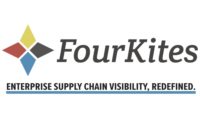Supply-chain logistics








The latest advances in logistics software give bakery and snack food manufacturers the ability to track and move product through the supply chain more efficiently than ever before. Logistics software is evolving as part of a strong shift in the focus on enterprise-planning technology. Predictive analysis, cloud computing, data collection and data interpretation are part of this rapidly advancing technology.
Despite these advances, bakery and snack food producers present a challenge to developers of logistics software. Some of the factors they routinely must deal with include the short shelf life of some bakery and snack products, managing the ever-increasing breadth and complexity of these products, the difficulty of accurately forecasting consumer demand and planning efficient production runs. Yet complete traceability down to the end delivery point is becoming more and more important.
“Bakery and snack food plants present the challenge of moving product with limited shelf life that calls for something different than the traditional receipt, store, pick-and-ship model,” says Tom Singer, principal at Tompkins International, Raleigh, N.C. “Many operations require a true flow-through model that starts from production to the delivery truck. Effective lot, code date and country of origin tracking are essential.”
Delivery requirements can challenge traditional solutions. Even if final delivery is performed by a third party, full visibility is needed between the producer and retailer. Shelf life and compressed order-to-delivery time place unique requirements on transportation planning, warehouse management and direct-store-delivery (DSD) solutions.
“Bakery and snack food plants move product primarily to distribution and retail outlets,” says Clay Gentry, vice president of logistics operations, Transportation Insight, Hickory, N.C. “Most of the logistics challenges are related directly to product that must arrive at specific times because of small delivery appointment windows or must-arrive-by-date (MABD) requirements. Logistics technology must be designed to account for the dynamic nature of these supply chains.”
Sales/merchandising tools
Much of the focus of DSD route software for bakery and snack food companies is on providing improved sales and merchandising tools, reducing operating costs and integrating vehicle telematics and fleet systems, according to Brian Schulte, industry marketing director, Intermec by Honeywell, Everett, Wash. “Competition is stronger than ever, and the pressure to increase or maintain sales margins is at an all-time high, particularly given fluctuations in commodity prices,” he notes.
New logistics software offerings can help move the process along while improving efficiency. “Full supply-chain suite and enterprise resource planning (ERP) vendors continue to grow their offerings,” says Singer. “They may start out with integrated warehouse and transportation management and demand planning/forecasting solutions, but subsequently add [business-to-business] e-commerce and visibility to their portfolio. This often is followed by a DSD or traceability offering.”
Piece by piece, leading vendors are filling out their solution sets to provide a complete supply-chain suite, attempting to span both planning and execution sides of the supply chain, experts agree. This not only presents the opportunity for one-stop shopping for logistics software, but it takes the integration challenge of interfacing disparate systems off the table.
Logistics software is changing as part of a bigger shift in the focus on enterprise-spanning technology, according to David F. Giannetto, senior vice president, performance management, Salient Management Co., Horseheads, N.Y. “The emphasis is no longer on simply processing transactions, or even processing transactions more efficiently, but on providing management insight into how to optimize an increasingly complex supply chain and how to improve margins both short- and long-term,” he explains.
Logistics software can provide a variety of ways to facilitate the distribution of goods. In the field, competencies around route optimization, global positioning system (GPS) tracking of delivery vehicles and real-time communications are just a few of the capabilities that can enhance an operation, says Chris Nelson, director of product strategy for delivery solutions, HighJump Software, Minneapolis. “Devices used in the field today have more power and features to help sales and the delivery person,” he says. “Applications on these devices can send orders and inventory levels back to the plant in real-time, which improves the entire operation.”
The interpretation of data also is improving, experts agree. Data collected from the field, production plant and back office can now be combined to provide bakery and snack manufacturers with information to evaluate sales trends, forecast production quantities and plan staffing levels.
Clouds come down to earth
Cloud-based computing is having a significant impact on the supply chain as well. “Cloud-based computing allows software vendors to provide demand-driven or SaaS solutions instead of the traditional licensed model where the customer runs the solution within internal data centers,” says Singer. “It provides a platform for visibility beyond the four walls of the plant. It also makes mobility a more effective and pervasive component.”
With their ability to easily pass data to and from the manufacturer or primary brand owner, cloud-based solutions offer value in an industry typified by individual supplier and distributor data sources, but this reality is still a work in progress, according to Giannetto. “Logistics software providers are still putting their energy and resources in the places where companies believe mobility solutions will pack the biggest punch: In the hands of those who are in the field and in the accounts—sales, account management and delivery drivers,” he says.
Cloud-based technology continues to make advances, particularly in areas where customization is not as critical and where network connectivity is typical, according to Schulte. “Because most bakery and snack food DSD routes do not have network connectivity in the field, interaction with cloud-based applications on the route is currently not common,” he says.
More flexible, predictable
Logistics software is also becoming more flexible and customizable. In response to continuous changes in requirements and company needs, logistics software providers are offering systems that can be better tailored to meet specific needs.
Traditional models of configurable functions and modules are being supplemented by extensibility tools that allow customers to enhance software without having a vendor modify the base code, according to Singer. “These solutions are typically based on open-source scripting and Java-based development tools,” he explains. “This allows companies using these solutions to hire or contract the needed technical talent off the street instead of training employees to learn a proprietary tool.”
Predictive analysis is another key trend in logistics software development. It offers the promise for companies to minimize their operating costs and improve their operational planning by better anticipating demand. In fact, most major suite and enterprise resource planning (ERP) vendors offer their own business warehouses with sophisticated data analysis and visualization capabilities. Demand sensing (a method that leverages new mathematical techniques and near real-time information to create an accurate forecast of demand, based on the current realities of the supply chain) is becoming an integral component of the demand-planning functions.
Many variables
For bakers and snack manufacturers, being able to predict trends depends on having an accurate forecast because so many variables come into play, according to Nelson. “Sales and delivery personnel can provide some information, but it also helps to consider factors such as holidays, the weather and local events—all of which can impact the demand for products, thus affecting an order forecast,” he says. “Software vendors are working on real-time solutions that can compile all this data and present it to users in a timely manner.”
Bakers and snack manufacturers have a chance to use predictive analysis to manage the entire supply chain, from raw material consumption to point-of-sale analysis, adds Jim Taylor, vice president of information technology at Transportation Insight. He provides this example: “You can get a 10-day weather forecast off the Internet, but what if you were able to leverage climate data for the last 100 years to measure trends and adjust the ordering of raw material and production resources based on these trends? If you could predict that kind of thing ahead of time, you would be much more proactive in the management of your total supply chain.”
Imaging, data visualization and voice-based solutions are also on the horizon and, in some cases, have already arrived. Voice-based solutions are being used to run put-to-store and load-building operations in many plants and warehouses, and are moving into the retail area for stocking and counting, according to Singer. These solutions will next move into DSD and transportation management as a mobility component.
However, logistics and supply-chain technology has been slow to adopt cutting-edge functionality such as digital imaging, data visualization and voice-based commands in progressive ways, Giannetto points out.
“Where companies can expect to see their greatest usage is in specific, task-oriented operations such as routing, inventory and warehouse space utilization and quality controls such as order-fill accuracy,” he says. “These functions within software systems are typically modular and, therefore, easier and cheaper to upgrade with increased functionality.”
Looking for a reprint of this article?
From high-res PDFs to custom plaques, order your copy today!













